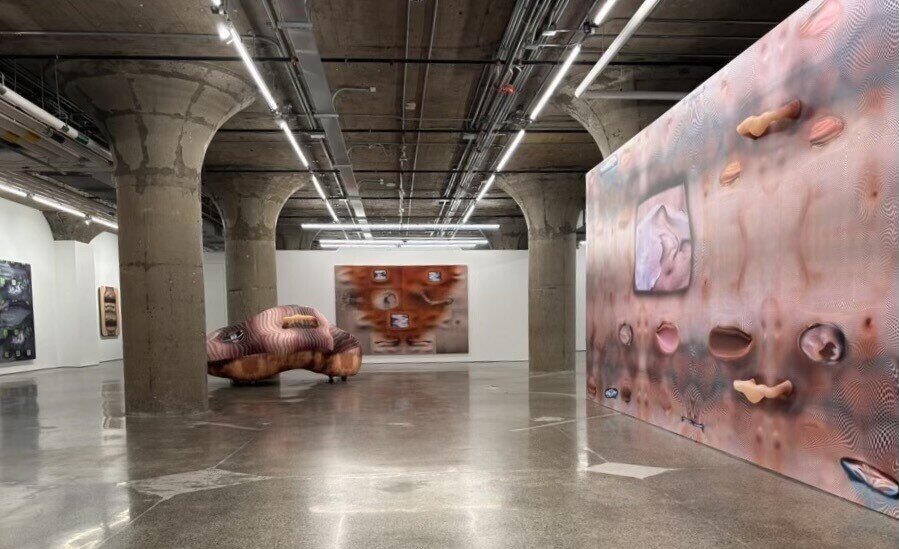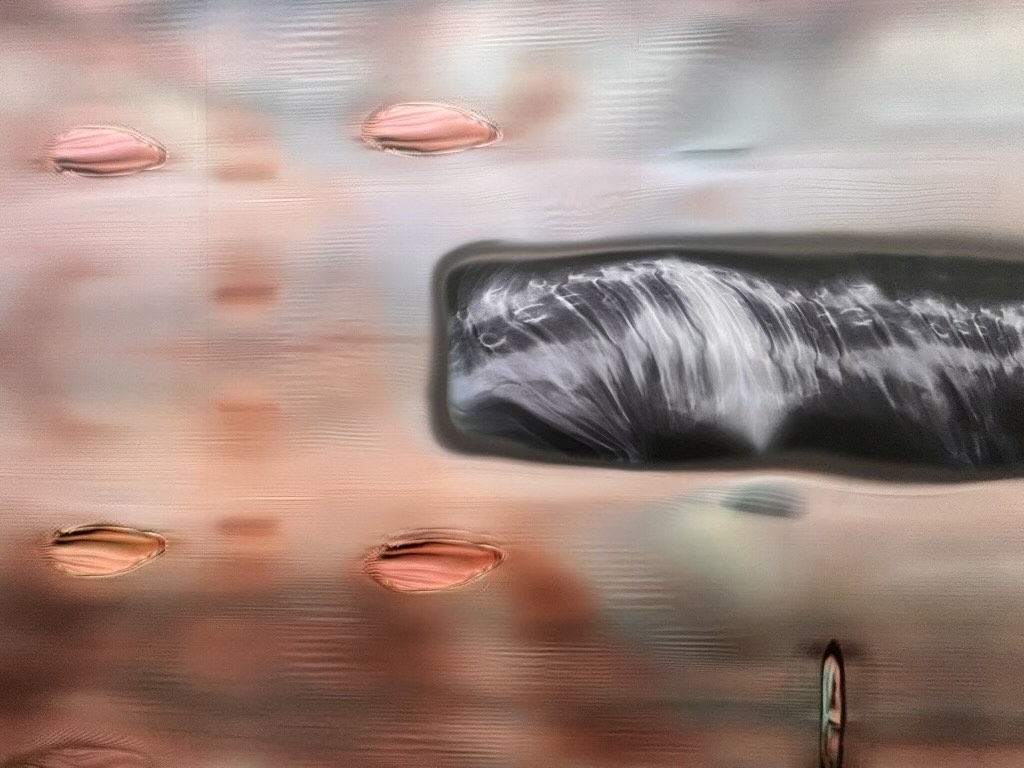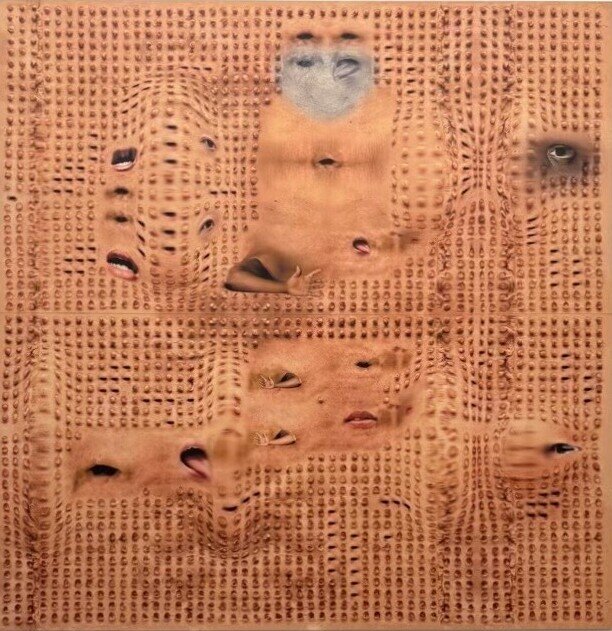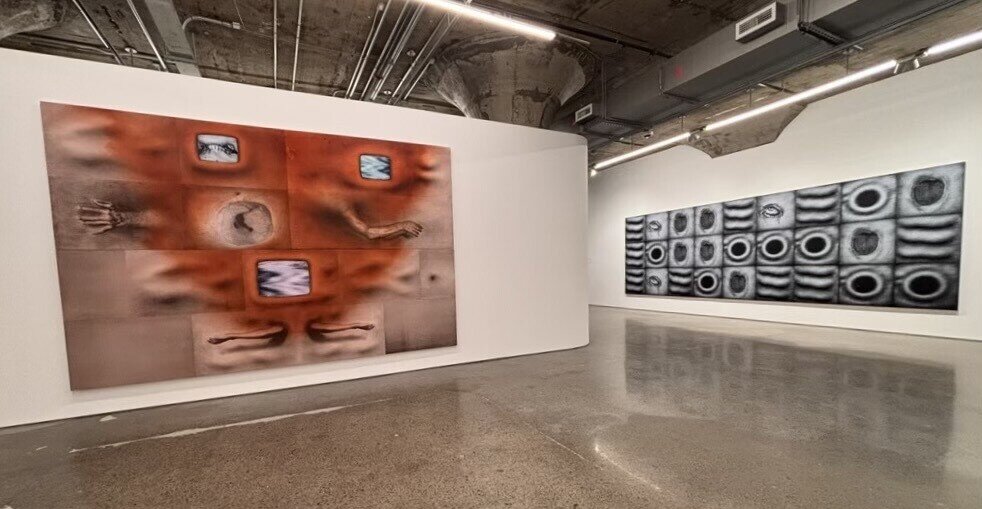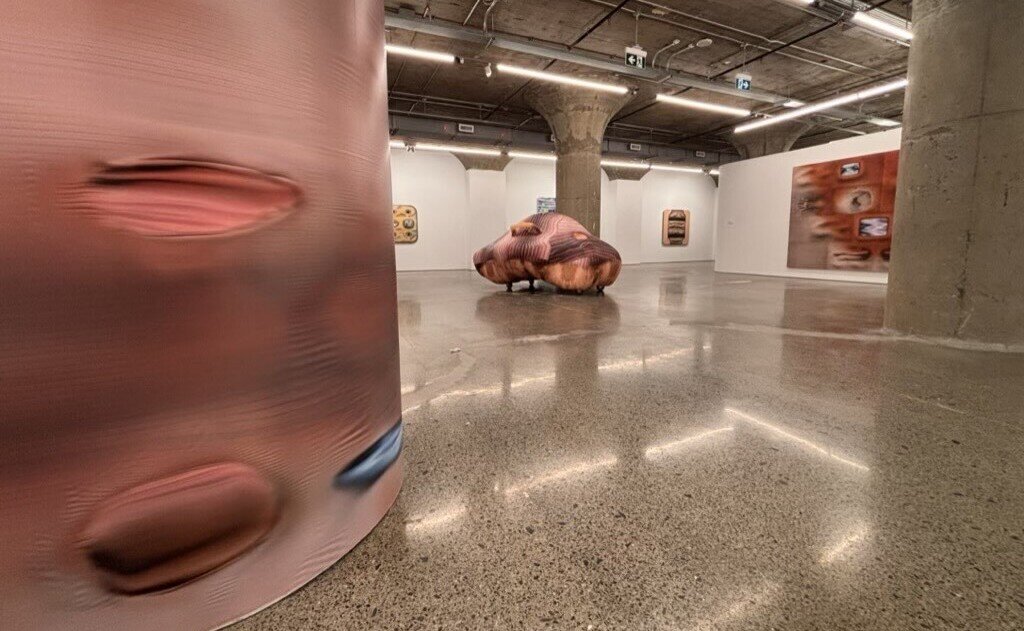Installation view of Tishan Hsu, Interface Remix at MOCA, 2025
Undoubtedly, we could all make the claim that technology has reshaped human identity and experience. While it has effectively transformed our lives, these radical changes should prompt us to question how our highly technical and digitally connected world has altered our sense of self. Tishan Hsu’s Interface Remix at the Museum of Contemporary Art (MOCA) explores these questions in a brutally honest and avant-garde manner, offering a compelling look at the complexities of modern existence while providing commentary on what is to come.
Close-up view of Tishan Hsu ear-screen-skin with casts: Toronto, 2024, inkjet on vinyl with acrylic
Upon entering the exhibition, the enormous installation titled ear-screen-skin with casts: Toronto (2024) shocks the viewer. This newly commissioned piece merges technologies with human characteristics, giving it a life of its own. Its hazy flesh-coloured surface appears to incorporate footage from surgical procedures, along with x-ray images of an elongated, manipulated spine and lurid open wounds. These elements contrast sharply with the metallic and acrylic limb-like handles protruding from the installation. This hybrid creation symbolizes our modern time, not only through its innovative design, which utilizes Photoshop and curved forms but also in its reflection of the human body — a body which has been transformed by technology, allowing us to repair and reshape ourselves according to new inventions and standards like those used in the creation of “ear-screen-skin with casts: Toronto”.
Tishan Hsu, Interface Remix, (2002), archival inkjet on canvas, two panels in total
Another stand-out piece is the titular “Interface Remix” (2002). This piece presents a grid of cloned and distorted human features—lips, mouths, and eyes— simultaneously reducing the human form to its individual components while multiplying them. The result is a striking visual that eliminates individuality and creates what Hsu describes as “a conceptual image of biotechnology.” This work explores the profound consequences of technology’s integration into our daily lives, highlighting how becoming increasingly reliant on technology can limit our sense of independence and objectify our reality—forcing us to live an objective, unnatural and therefore distorted life. Furthermore, this fragmented yet repetitive display of human elements serves as a powerful commentary on technology’s aspirations and its impact on our natural identities. Other works like “Splits” (1996) and “mammal-screen” (2023), also explore the themes of bodily modification, identity in the digital age, and the blurred lines between the organic and the technological parts of our modern world.
Installation view with Tishan Hsu, Splits, 1996, silkscreen ink, acrylic on canvas (left) and Cellular Automata 3.0, 1989/2018, silkscreen ink, acrylic on canvas (right)
Tishan Hsu’s “Cellular Automata 3.0” (1989/2018) explores the limitations of the human body through a graphic black-and-white pattern featuring alternating close-ups of worn-out limbs. Hsu features heavy, glassy eyes that gaze upward and remain open despite their clear exhaustion, and dry, passive mouths that extend their tongues. Surrounding these natural facial features, there are more of Hsu’s subhuman body parts, including lumps and perfectly circular orifices. I believe this acrylic painting reflects our insatiable desire for entertainment and innovation in the digital age. “Cellular Automata 3.0” explores how the excessive use of technology has made us idle and drained our bodies, even though their use requires our minimal effort. Ultimately, this reliance on technology diminishes us, hindering the development of critical skills that could enrich our humanity and shape our unique identities.
Installation view of Tishan Hsu, Interface Remix at MOCA, 2025
Tishan Hsu’s Interface Remix presents a future that, while strange and disheartening, holds possibility. The artist invites us to explore the potential of the relationship between technology and human identity by exaggeratedly outlining the extent of our reliance on it and integration of it into our everyday lives. Interface Remix raises important questions about how technological advancements affect our understanding of individuality and existence in an increasingly interconnected world. Ultimately, Tishan Hsu’s work challenges us to consider whether technology’s ability to connect us and foster our development is ultimately beneficial. Tishan Hsu compels us to confront the illusions and perceptions that shape both modern art and our lives.
Text and photo: Antonella Pecora Ruiz
*Exhibition information: Tishan Hsu, Interface Remix, September 28, 2024 – February 23, 2025, Museum of Contemporary Art, 158 Sterling Rd, Toronto. Museum hours: Wed – Thu & Sat – Sun 11 am – 6 pm; Fri 11 am – 9 pm.

